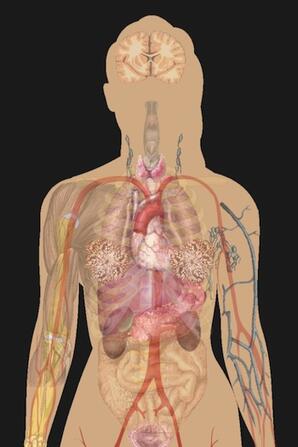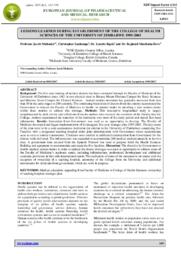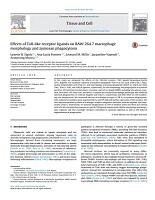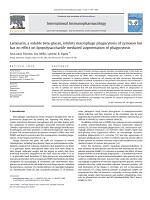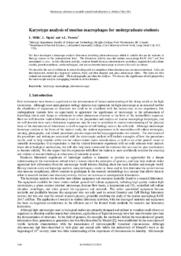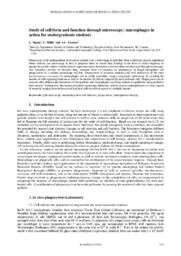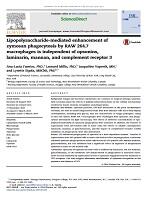Sigola, Lynette B.
Person Preferred Name
Lynette B. Sigola
Person Alternate Names
Lynette Sigola
Position
Faculty Member
Field of Activity
Neurohormonal Regulation of Inflammation
Macrophage Immunity
Innate Immunity
Email/Contact
sigolal@douglascollege.ca
Department
Status
current
Affiliation Date
2004
Education and Credentials
PhD (University of London)
MBChB (University of Zimbabwe)
BSc (Hons) (University of Zimbabwe)
Douglas College Faculty member since 2004.
Lynette's research is in cell biology, immunology and human biology.
PhD (University of London)
MBChB (University of Zimbabwe)
BSc (Hons) (University of Zimbabwe)
Douglas College Faculty member since 2004.
Lynette's research is in cell biology, immunology and human biology.
Related Works
Content type
Digital Document
Abstract
Tuberculosis (TB) is one of the leading causes of death from infectious diseases, killing approximately 1.3 million people worldwide in 2022 alone. The current vaccine for TB contains a live attenuated bacterium, Mycobacterium bovis BCG (Bacille Calmette-Guérin). The BCG vaccine is highly effective in preventing severe forms of childhood TB but does not protect against latent infection or disease in older age groups. A new or improved BCG vaccine for prevention of pulmonary TB is urgently needed.
In this study, we infected murine bone marrow derived dendritic cells from C57BL/6 mice with M. bovis BCG followed by elution and identification of BCG-derived MHC class I and class II-bound peptides using tandem mass spectrometry. We identified 1436 MHC-bound peptides of which 94 were derived from BCG. Fifty-five peptides were derived from MHC class I molecules and 39 from class II molecules. We tested the 94 peptides for their immunogenicity using IFN- γ ELISPOT assay with splenocytes purified from BCG immunized mice and 10 showed positive responses. Seven peptides were derived from MHC II and three from MHC class I. In particular, MHC class II binding peptides derived from the mycobacterial surface lipoprotein Mpt83 were highly antigenic. Further evaluations of these immunogenic BCG peptides may identify proteins useful as new TB vaccine candidates.
Origin Information
Content type
Digital Document
Abstract
This textbook is a project under development by our Biology faculty to ultimately provide students with all the factual information they need to succeed in the BIOL 1203 and BIOL 1209 courses at Douglas College in BC, Canada. It was developed initially as an adaptation of the OpenStax Anatomy & Physiology textbook, freely available online at http://cnx.org/content/col11496/latest/. The original adaptations of that OpenStax textbook for Douglas College are accessible online at https://pressbooks.bccampus.ca/dcbiol11031109/ and https://pressbooks.bccampus.ca/dcbiol12031209/ In the first edition of the Douglas College adaptations the chapter and section numbers were left as they were in the version of the OpenStax A&P textbook, from which they were largely drawn. However, this second edition has been more extensively edited and rearranged to correspond with the curriculum used at Douglas College, so chapter and section numbers are no longer aligned specifically with the OpenStax A&P textbook.
Origin Information
Content type
Digital Document
Abstract
Background: The five year training of medical doctors has been conducted through the Faculty of Medicine of the University of Zimbabwe since 1963 in two physical sites in Harare; Mount Pleasant Campus for Basic Sciences and Mazowe Street Campus for Clinical Sciences. Annual student enrolment has gradually increased from less than 30 in the early stages to 200 currently. The continuing brain drain of doctors from the country necessitated the Government to instruct the Faculty of Medicine to double its student intake by enrolling a new student intake within three months to address this shortage.
Methods: This descriptive longitudinal study is largely complemented by desk review and reflections from the authors who oversaw the evolution of the Faculty into the College. Authors experienced the transition of the institution over most of the study period and shared first-hand information.
Results: Instruction from Government was used as an opportunity to develop. The Faculty of Medicine developed and began implementation of its inaugural five year strategic plan 1995-2001. The key tenets of the plan were to be a semi-autonomous institution (in relation to the University of Zimbabwe) comprising five Faculties with a designated teaching hospital under joint administration with Government where academicians were to receive similar emoluments. Clinicians were entitled to additional remuneration from Government for the clinical work delivered. The infrastructure was expanded to accommodate 200 medical students annually at the two sites. A government loan secured from the Spanish Protocol was used to purpose build the Health Sciences Building and equipment to accommodate and equip the five faculties.
Discussion: The directive by Government to double medical student intake in order to address the doctor shortages was used as opportunity to address some of the Faculty of Medicine’s academic needs, including infrastructure, professional development and additional academic provisions in line with international trends. The realization of some of the outcomes is on course with the exception of ownership of a teaching hospital, autonomy of the College from the University and additional emoluments for clinicians from government, which are work in progress.
Origin Information
Content type
Digital Document
Abstract
In this study we compared the effects of the Toll-like receptor (TLR) ligands lipopolysaccharide (LPS), flagellin, the synthetic bacterial triacylated lipopeptide Pam3-Cys-Ser-Lys4 (Pam3CSK4), Polyinosinic:polycytidylic acid (Poly I:C), and macrophage-activating lipopeptide (MALP-2), which are TLR4, TLR5, TLR1/2, TLR3, and TLR2/6 agonists, respectively, on cell morphology and phagocytosis of zymosan particles, derived from Saccharomyces cerevisiae, and rich in fungal PAMPs including beta-glucan, mannose, and chitin. LPS, Pam3CSK4, and MALP-2 induced an activated macrophage phenotype and enhanced zymosan phagocytosis. In contrast, flagellin and Poly I:C, respectively, had little effect on cell morphology and phagocytosis. We examined the role of scavenger receptor A (SR-A) on zymosan phagocytosis. Cells cultured in medium alone expressed SR-A, and LPS induced further expression of the receptor. We also observed inhibitory effects of scavenger receptor antagonists fucoidan, dextran sulphate, and Polyinosinic (Poly I), respectively, on zymosan phagocytosis of cells in medium alone and those pre-treated with LPS. We conclude that exposure to specific TLR ligands impacts both cellular morphology and phagocytic capacity, and that scavenger receptors contribute to zymosan ingestion as well as LPS-induced augmentation of phagocytosis.--Publisher.
Origin Information
Content type
Digital Document
Abstract
In recent years, information on the diversity and abundance of microorganisms associated with the human body has significantly expanded. Recent research on the microbiota reveals its importance in the maintenance of normal host physiology and particular dysbioses have been associated with disturbances of gastrointestinal and metabolic health, brain function, and immunological responses. College students in health sciences and related programs, to our knowledge, receive little information regarding the microbiota and its importance in health. Adequate descriptions of the microbiota are only recently starting to appear in undergraduate human anatomy and physiology textbooks and most curricula fail to address the topic of microbiota with the attention that it deserves. Given the growing amount of evidence demonstrating the vital role of the microbiota in body function, it is crucial to educate students about the microbiota in undergraduate human anatomy and physiology courses for health practitioners. In this review, we present examples of recent findings illustrating the importance of the microbiota, and discuss how we may incorporate the microbiota into the teaching of human anatomy and physiology courses
Origin Information
Content type
Digital Document
Abstract
Phagocytosis is a fundamental aspect of innate resistance against microbes, including fungi. In this study we investigated the significance of beta-glucan on the surfaces of zymosan particles, derived from Saccharomyces cerevisiae, during phagocytosis by RAW 264.7 macrophages. Phagocytosis was assessed in vitro by macrophage exposure to zymosan particles followed by cell staining and light microscopy. Macrophage ingestion of zymosan was dependent on cellular recognition of the particles' beta-glucans since laminarin, a soluble beta-glucan, inhibited phagocytosis in a concentration dependent manner when added to cell cultures. In contrast, the presence of another carbohydrate, mannan, had no effect on zymosan phagocytosis by cells. In addition we showed that LPS and dexamethasone had opposing effects on phagocytosis of zymosan. LPS significantly augmented ingestion while in contrast dexamethasone, like laminarin, suppressed it. The LPS-enhanced ingestion of zymosan was insensitive to the presence of laminarin in cell cultures, however dexamethasone partially ameliorated the effects of LPS on phagocytosis. Our findings confirm beta-glucan as an important ligand identified by macrophages and required for zymosan phagocytosis in naïve cells, but not in cells previously exposed to LPS.--Publisher.
Origin Information
Content type
Digital Document
Abstract
The chapter, "Karyotype analysis of murine macrophages for undergraduate students" was written by the listed authors including Lynette B. Sigola (Douglas College Faculty). We have developed a karyotype analysis laboratory involving photomicroscopy which is suitable for use by students in biology courses at the undergraduate level. The laboratory activity uses the murine macrophage RAW 264.7 cell line maintained in vitro. In this laboratory activity, students benefit from an introduction to conditions required for cell culture (media, growth conditions, sterile technique), and use an inverted microscope to observe live cells in culture.
We describe the use of colchicine to arrest dividing cells in metaphase when chromosomes are most condensed. Cells are then harvested, treated in a hypotonic solution, fixed, and then dropped onto glass microscope slides. The slides are then stained and mounted and sealed. Photomicrographs are taken for analysis. We discuss the significance of cell preparation for microscopic analysis in engaging students as active learners.
Origin Information
Content type
Digital Document
Abstract
The chapter, "Study of cell form and function through microscopy: Macrophages in action for undergraduate students" was written by the listed authors including Lynette B. Sigola (Douglas College Faculty). Microscopy at the undergraduate level can be pursued over a wide range of activities, from a relatively passive experience where students use microscopy to look at prepared slides to record their findings in the form of sketch diagrams, to inquiry-based labs, where students learn to appreciate many dimensions of observation and discovery through microscopy. The laboratory activity we describe here, stemmed from our research on mechanisms of fungal recognition and phagocytosis of a murine macrophage cell line. Phagocytosis of zymosan particles (cell wall derivatives of the yeast Saccharomyces cerevisiae) by macrophages can be easily quantified, using a compound microscope, by counting the number of cells ingesting zymosan as well as the number of particles ingested by each particular cell. Phagocytosis can be assessed after different pre-treatments of both particles and macrophages, involving students in qualitative and quantitative data analysis. Furthermore, this research-inspired microscopy laboratory activity exposes undergraduates to many aspects of research, ranging from technical and logistical skills to ethical aspects of scientific inquiry.
Origin Information
Content type
Digital Document
Abstract
Conference presentation delivered at the 15th <a href="http://www.aegeanconferences.org/src/App/conferences">Aegean Innate Immunity Conference (Chania, Crete, Greece, 2018)</a>.
<p>Phagocytosis is a fundamental cellular activity preserved in a broad spectrum of eukaryotic organisms, from simple unicellular protists where it is used for the ingestion of food particles, to complex multicellular organisms where phagocytosis is an essential component of innate immunity against invading microorganisms. In this study, we report on the effect of glucose on phagocytosis in the model protist Tetrahymena pyriformis. Initial experiments examined the effects of temperature and contact time with the phagocytic target India ink, on phagocytosis by Tetrahymena. Phagocytosis was assessed by counting the number of phagocytic vacuoles in cells fixed with glutaraldehyde and visualized by light microscopy. Phagocytosis was maximal at room temperature and after 30 min of incubation with India ink. Glucose suppressed phagocytosis in a concentration-dependent manner. In addition, we demonstrated that exposure of cells to other hypertonic solutions, including sucrose, fructose, galactose and mannitol, used at 25mM concentrations, respectively, suppressed phagocytosis. Furthermore, we showed that hypotonic conditions, including incubation of cells in distilled water or diluted proteose peptone culture medium, had little effect on phagocytosis of India ink by Tetrahymena. Our studies may be relevant in elucidating the role of glucose and/or hypertonicity in contributing to impaired phagocytosis, and possibly enhanced risk of infections, in patients with untreated or poorly controlled diabetes mellitus, a condition associated with hyperglycemia.</p>
Origin Information
Content type
Digital Document
Abstract
Background: Fungal and bacterial coinfections are common in surgical settings; however, little is known about the effects of polymicrobial interactions on the cellular mechanisms involved in innate immune recognition and phagocytosis.
<p>Materials and methods: Zymosan particles, cell wall derivatives of the yeast Saccharomyces cerevisiae, are used to model fungal interactions with host immune cells since they display carbohydrates, including beta-glucan, that are characteristic of fungal pathogens. Using in vitro cell culture, RAW 264.7 macrophages were challenged with zymosan, and phagocytosis determined via light microscopy. The effects of different concentrations of lipopolysaccharide (LPS) on zymosan phagocytosis were assessed. In addition, the transfer of supernatant from LPS-treated cells to naive cells, the effects of soluble carbohydrates laminarin, mannan, or galactomannan, and the impact of complement receptor 3 (CR3) inhibition on phagocytosis were also determined.
<p>Results: LPS enhanced phagocytosis of zymosan in a dose-dependent manner. Transfer of supernatants from LPS-primed cells to naı¨ve cells had no effect on phagocytosis. Laminarin inhibited zymosan phagocytosis in naı¨ve cells but not in LPS-primed cells. Neither mannan, galactomannan, nor CR3 inhibition had a significant effect on ingestion of unopsonized zymosan in naı¨ve or LPS-treated cells.
<p>Conclusions: Zymosan recognition by naı¨ve cells is inhibited by laminarin, but not mannan, galactomannan, or CR3 inhibition. LPS enhancement of phagocytosis is laminarin insensitive and not mediated by supernatant factors or zymosan engagement by the mannose or CR3 receptors. Our data suggest alternative mechanisms of zymosan recognition in the presence and absence of LPS.
Origin Information



